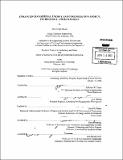Enhanced geothermal energy and cogeneration : design, technology and economics
Author(s)
Ehsani, Shoa-Ollah, 1967-
DownloadFull printable version (40.19Mb)
Other Contributors
Massachusetts Institute of Technology. Dept. of Civil and Environmental Engineering.
Advisor
Jefferson W. Tester.
Terms of use
Metadata
Show full item recordAbstract
The search for and the development of new sources of energy continue to gather importance into the 2 1st century. One of the options at hand is mining heat from the earth's crust. The U.S. Department of Energy has supported research into Enhanced Geothermal Systems in Hot Dry Rock (HDR) since the mid seventies. Advances in drilling technology, reservoir management and power conversion cycles have all contributed to the further development of HDR geothermal energy schemes. Apart from outlining and reviewing some of the specific characteristics of Enhanced Geothermal Energy Systems, this thesis investigates the possibility of using HDR technology for commercial scale combined heat and electric power applications. This is carried out through cogenerative design of current HDR electric power plant options with direct process heat capacity required in industrial production today. The MIT EGS Simulator was modified to accommodate cogeneration to assess the success of such designs in three separate, industrial case studies. Overall system busbar cost for electricity produced and various thermodynamic efficiency measures will be used as metrics to access the effectiveness of cogeneration design in HDR power generation. Lastly, this research is used to qualitatively evaluate the performance of other low-temperature electric-power and direct use cogeneration designs; one of the important aspects in a move towards increased global energy efficiency.
Description
Thesis (S.M.)--Massachusetts Institute of Technology, Engineering Systems Division, Technology and Policy Program; and, (S.M.)--Massachusetts Institute of Technology, Dept. of Civil and Environmental Engineering, 2003. Includes bibliographical references (p. 114-116).
Date issued
2003Department
Massachusetts Institute of Technology. Department of Civil and Environmental Engineering; Massachusetts Institute of Technology. Engineering Systems Division; Technology and Policy ProgramPublisher
Massachusetts Institute of Technology
Keywords
Technology and Policy Program., Civil and Environmental Engineering.